Friendship with a chatbot? MindLabs is working on AI with human traits
MindLabs opened its doors two years ago. It had to become an AI breeding ground where people, ideas, practice and theory come together. Has that idea been realized, Univers asked director Petra van Dijk. ‘This is where theory and practice meet.’

The interaction between humans and AI is central to the striking MindLabs building next to the LocHal, the soft side of the AI revolution. And Tilburg University also wants to play a major role in this. Because MindLabs is also a bit ours: the university is one of the partners, alongside Fontys, Yonder and the municipality of Tilburg.
Ecosystem
‘We like to think of ourselves as an ecosystem,’ says director Petra van Dijk. ‘We are a portal where questions from the outside world and solutions from research and technology come together. That is the added value of MindLabs. This is where theory and practice meet.’
As a meeting place and pivot in a network, MindLabs offers companies, institutions and governments the opportunity to connect with each other and strengthen each other: ‘We are experimenting with human-centred technology,’ says Van Dijk. ‘And we have a lot of young talent at work, interns who get to work with companies, healthcare institutions, but also with our own research groups and projects.’
Human traits
During the annual event Faces of the future that took place last week, visitors got a glimpse of a future with so-called virtual humans. Because chatbots are getting more and more human traits, with a lifelike voice and facial expressions that can mimic human emotion. These human avatars can be used as a teacher, coach or digital buddy, among other things.
In a day full of keynotes, workshops and demonstrations, participants were able to exchange ideas and get ideas about the future of the AI revolution. ‘We think those vistas are important,’ says Van Dijk. ‘We are working on themes that are emerging now and will only become more topical in the coming years. In doing so, we ask questions and investigate what we as a society want with those applications.’
Virtual newsreader
MindLabs is more than a meeting place. In the labs, research teams are working on the development of virtual humans, among other things. ‘Last year, for example, we tested a prototype for elderly care, together with Yonder (ROC Tilburg),’ says Van Dijk. ‘We use sensor technology to reduce loneliness among the elderly with the help of a digital buddy.
Visitors can also see new applications during the event. Omroep Brabant was working on a virtual newsreader. In one of the labs, students are commissioned by the broadcaster to investigate how viewers experience such a news avatar. In doing so, they look critically at the advantages, but also at the disadvantages: how reliable does such an AI newsreader come across and who is responsible for the news?
Hybrid realities
Immersion in an artificial world often provides ‘lifelike’ experiences. And those AI experiences are increasingly intermingling with the experiences of everyday life into a hybrid reality where real and artificial experiences are intertwined and increasingly difficult to distinguish.
Pandora’s box is open, the speakers at the event observe. Within ten years, virtual humans will behave so naturally that the artificial aspect is hardly noticeable anymore. For example, it is already possible to breathe new life into dead people with AI. As a museum visitor, you can then get a tour from a virtual Dali or Van Gogh. You could also use AI to confront suspects and perpetrators in court with their deceased victims.
Surf
By now, most students know what prompting is and many people also use AI as a tool for online searching. This also creates new applications: ‘I use it to come up with stories for the children around bedtime,’ confesses a participant during a Q&A session in the room.
MindLabs clearly has the wind in its sails. ChatGPT came out at the end of 2022 and this language model grew into the figurehead of the AI revolution in the years that followed. ‘We had a beautiful building, a new form of collaboration, and a hype,’ laughs Van Dijk.
Emotional connection
During the event, the ‘human side’ of AI is mainly central. Because virtual humans will be used more and more often in the future and will take on more and more human traits. In this way, we can even develop an emotional connection with chatbots.
But for many participants, entering into a ‘relationship’ with a virtual human is still a step too far. Only one hand goes up in the room when asked if you ever experience a click with a chatbot. ‘I had such a click this week,’ the speaker confesses. Whether such a band is desirable remains a question that will be heard frequently in the coming years.






